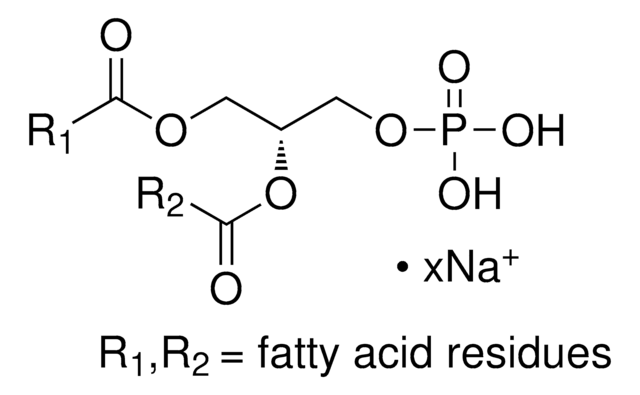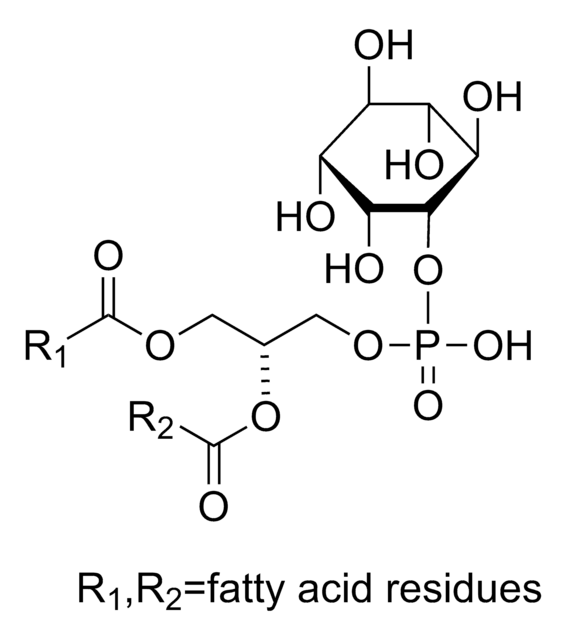추천 제품
제품 라인
BioReagent
형태
powder
기술
cell culture | insect: suitable
cell culture | mammalian: suitable
cell culture | plant: suitable
EEO
≤0.1
mp
≤65 °C ( at a 1.5% gel)
전이 온도
congealing temperature 26-30 °C
겔 강도
≥200 g/cm2 (1% gel)
solubility
H2O: 10 mg/mL (with heat)
음이온 미량물
sulfate (SO42-): ≤0.10%
외래 활성
RNase and DNase free
일반 설명
Agarose is an algal polysaccharide. Agarose is a thermoreversible, ion-dependent gelling agent. Agarose gel electrophoresis is useful for the clinical routine analyses of proteins in plasma and other body fluids. It is a low gelling temperature derivative with unique gelling properties. Gels forms at <30°C, remelt at temperatures in excess of 60°C. Gels exhibit excellent clarity and are particularly useful for the preparation of media containing heat-labile materials.
애플리케이션
Agarose, a low gelling temperature derivative, is the suitable reagent for:
It may be used for the following studies:
- plant cell culture studies
- insect cell culture studies
- cell culture studies
It may be used for the following studies:
- Recovery of defined RNA and DNA fractions after electrophoretic separation.
- Cytochemical staining procedure to investigate the succinate dehydrogenase (SDH) activity in pre-ovulatory mouse oocytes.
- Purification of RNA in Caenorhabditis elegans by electrophoresis.
분석 메모
The following is a list of properties associated with our agaroses:
Sulfate content - used as an indicator of purity, since sulfate is the major ionic group present.
Gel strength - the force that must be applied to a gel to cause it to fracture.
Gel point - the temperature at which an aqueous agarose solution forms a gel as it cools. Agarose solutions exhibit hysteresis in the liquid-to-gel transition - that is, their gel point is not the same as their melting temperature.
Electroendosmosis (EEO) - a movement of liquid through the gel. Anionic groups in an agarose gel are affixed to the matrix and cannot move, but dissociable counter cations can migrate toward the cathode in the matrix, giving rise to EEO. Since electrophoretic movement of biopolymers is usually toward the anode, EEO can disrupt separations because of internal convection.
Sulfate content - used as an indicator of purity, since sulfate is the major ionic group present.
Gel strength - the force that must be applied to a gel to cause it to fracture.
Gel point - the temperature at which an aqueous agarose solution forms a gel as it cools. Agarose solutions exhibit hysteresis in the liquid-to-gel transition - that is, their gel point is not the same as their melting temperature.
Electroendosmosis (EEO) - a movement of liquid through the gel. Anionic groups in an agarose gel are affixed to the matrix and cannot move, but dissociable counter cations can migrate toward the cathode in the matrix, giving rise to EEO. Since electrophoretic movement of biopolymers is usually toward the anode, EEO can disrupt separations because of internal convection.
Storage Class Code
11 - Combustible Solids
WGK
WGK 3
Flash Point (°F)
Not applicable
Flash Point (°C)
Not applicable
개인 보호 장비
Eyeshields, Gloves, type N95 (US)
시험 성적서(COA)
제품의 로트/배치 번호를 입력하여 시험 성적서(COA)을 검색하십시오. 로트 및 배치 번호는 제품 라벨에 있는 ‘로트’ 또는 ‘배치’라는 용어 뒤에서 찾을 수 있습니다.
이미 열람한 고객
M L Boerjan et al.
The journal of histochemistry and cytochemistry : official journal of the Histochemistry Society, 39(1), 135-138 (1991-01-01)
We describe a cytochemical staining procedure for succinate dehydrogenase (SDH) activity in pre-ovulatory mouse oocytes. The oocytes were embedded in low gelling temperature agarose and treated with caffeine before cytochemical staining in the presence of nitro blue tetrazolium (NBT), phenazinemethosulfate
A Fire et al.
Nature, 391(6669), 806-811 (1998-03-05)
Experimental introduction of RNA into cells can be used in certain biological systems to interfere with the function of an endogenous gene. Such effects have been proposed to result from a simple antisense mechanism that depends on hybridization between the
Katherine A Pillman et al.
The EMBO journal, 37(13) (2018-06-07)
Members of the miR-200 family are critical gatekeepers of the epithelial state, restraining expression of pro-mesenchymal genes that drive epithelial-mesenchymal transition (EMT) and contribute to metastatic cancer progression. Here, we show that miR-200c and another epithelial-enriched miRNA, miR-375, exert widespread
Agarose gel electrophoresis.
Johansson B G.
Scandinavian Journal of Clinical and Laboratory Investigation, 29(S124), 7-19 (1972)
Nariko Arimura et al.
Science advances, 6(36) (2020-09-13)
For normal neurogenesis and circuit formation, delamination of differentiating neurons from the proliferative zone must be precisely controlled; however, the regulatory mechanisms underlying cell attachment are poorly understood. Here, we show that Down syndrome cell adhesion molecule (DSCAM) controls neuronal
자사의 과학자팀은 생명 과학, 재료 과학, 화학 합성, 크로마토그래피, 분석 및 기타 많은 영역을 포함한 모든 과학 분야에 경험이 있습니다..
고객지원팀으로 연락바랍니다.



